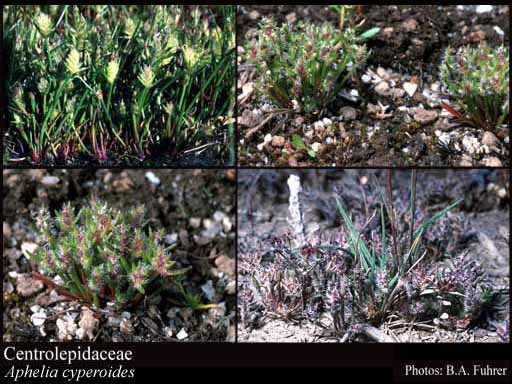- Reference
- Gen.Pl. 2:119 (1836)
- Name Status
- Current

Scientific Description
Common name. Centrolepis Family.
Habit and leaf form. Grass- or mosslike herbs. Annual, or perennial; plants with a basal concentration of leaves (when annual), or with neither basal nor terminal concentrations of leaves. Leaves alternate; spiral; sessile; sheathing. Leaf sheaths with free margins. Leaves edgewise to the stem (rarely), or with ‘normal’ orientation; simple. Leaf blades entire; setaceous, or linear; parallel-veined. Leaves ligulate, or eligulate; with a persistent basal meristem, and basipetal development. Vegetative anatomy. Plants with silica bodies, or without silica bodies. Leaf anatomy. Leaf blade epidermis without differentiation into ‘long’ and ‘short’ cells. Guard-cells ‘grass type’ (according to the text of Dahlgren et al. (1985), though their illustration of Pseudalepyrum depicts them otherwise). Stem anatomy. Secondary thickening absent.
Reproductive type, pollination. Fertile flowers functionally male and functionally female, or hermaphrodite and functionally male, or hermaphrodite, functionally male, and functionally female. Unisexual flowers present. Plants monoecious, or andromonoecious, or polygamomonoecious. The unisexual flowers segregated in different inflorescences. Male flowers with pistillodes. Floral nectaries absent (nectaries absent). Anemophilous.
Inflorescence and flower features. Flowers aggregated in ‘inflorescences’; in ‘spikelets’ (each ‘pseudanthium’ being borne within two or more glumelike bracts). The terminal inflorescence unit cymose. Inflorescences pseudanthial (as currently interpreted, the bisexual and female heads of Centrolepis and Gaimardia being seen as unisexual and bisexual aggregations of flowers, each of the latter being reduced to either one stamen or one carpel). Flowers bracteate; bracteolate (the flowers sometimes with thin subtending ‘bractlets’), or ebracteolate; small. Perianth absent. Androecium present (male flower), or absent (female flower). Fertile stamens present, or absent (from female flowers). Androecium 1 (constituting the male flower, as here interpreted). Androecium exclusively of fertile stamens. Stamens 1. Anthers dorsifixed; versatile; dehiscing via longitudinal slits; bisporangiate. Fertile gynoecium present (female flower), or absent (male flower). Gynoecium 1 carpelled (constituting the female flower). The pistil 1 celled. Gynoecium monomerous; of one carpel; superior. Carpel 1 ovuled. Placentation apical. Ovary stipitate. Ovules pendulous; non-arillate; orthotropous.
Fruit and seed features. Fruit non-fleshy. The fruiting carpel dehiscent; a follicle (tiny). Gynoecia of adjoining flowers combining to form a multiple fruit (the collective fruits capsule-like). Dispersal unit the seed. Seeds copiously endospermic. Endosperm not oily (starchy). Perisperm absent. Seeds with starch. Embryo rudimentary at the time of seed release (minute, obconical). Seedling. Germination epigeal (seed remnant visible on apex of the cotyledon (which appears as the basal leaf)). Hypocotyl internode absent. Mesocotyl absent. Seedling collar not conspicuous. Cotyledon hyperphyll elongated; assimilatory; more or less circular in t.s. Coleoptile absent. Seedling cataphylls absent. First leaf centric. Primary root ephemeral.
Physiology, biochemistry. Aluminium accumulation demonstrated (Centrolepis).
Geography, cytology, number of species. World distribution: Southeast Asia and Australasia. X = 10–13. 40 species.